Gistok Member Username: Gistok Post Number: 6046 Registered: 08-2004 |
I thought I would post some historic information about the Detroit United Artists Theatre on Bagley Ave. The United Artists studios were founded in 1919 by movie stars Charlie Chaplain, Douglas Fairbanks Sr., Mary Pickford and director D. W. Griffiths. Throughout the 1920's they struggled as a studio. Their only movie palaces were the trio designed by Detroit architect C. Howard Crane... the 2,200 seat Los Angeles UA, the 1,739 seat Chicago UA, and the 2,070 seat Detroit UA. All other 1920's movie palaces with the UA name had it co-named with Loew's Theatres (such as the 1929 Louisville Loew's-United Artists). So this trio of United Artists theatres in LA, Chicago and Detroit were the only standalone United Artists movie palaces in existence. Although I was going to repeat much of the information that the Theatre Historical Society had on these 3 wonderful movie palaces, Detroit booster David Kohrmann has already done so on his great website... http://www.forgottendetroit.com/uat/history.html One thing that I always wondered about the UA Building was why the side of the building facing Grand Circus Park looked so different. Here's a recent picture showing much of that side facade covered up by an Ilitch Holding banner: 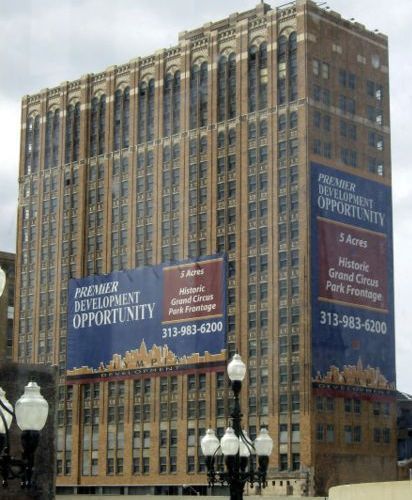 Well I finally found out why this side looks different. In this 1928 (THS) photo, it shows that side of the building (nearly bordering the former Tuller Hotel) with no windows whatsoever. So at some later date, it was determined to remodel that side and add windows and architectural brickwork... hence the different design than the front of the building. 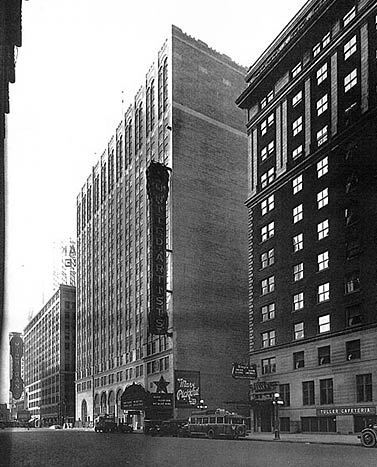 Also notice in the background of this picture one can see the marquee of the Michigan Theatre. Rising a full 10 stories, the marquee of the Michigan was the tallest vertical marquee ever produced. Gistok | ||
Jjaba Member Username: Jjaba Post Number: 5897 Registered: 11-2003 |
Excellent Gistok. Great opening of another show. Read the Detroit CORE thread for jjaba's 1960s involvement at UA AAA offices. jjaba. | ||
Gistok Member Username: Gistok Post Number: 6050 Registered: 08-2004 |
Thanks Jjaba, I read your thread. Very interesting. In this last picture of the UA, it is interesting to note the white stone or brick in a "-" (dash) pattern on the blank wall, near the top. It looks as though they were anticipating the possibility of later punching windows thru that side of the building. | ||
Mauser765 Member Username: Mauser765 Post Number: 2276 Registered: 01-2004 |
Gotta dig the "Mary Pickford" sign on the side of the UA. She was one of the organizers of the United Artists. | ||
Exmotowner Member Username: Exmotowner Post Number: 445 Registered: 06-2005 |
Any new news on the happenings with this theater? I was hoping you would tell us its being restored? | ||
Kenp Member Username: Kenp Post Number: 959 Registered: 03-2006 |
My Aunt talked a lot about the old theaters. She told me she thought the Michigan was the nicest. Any of the elders here have any opinions on their favorite. Great thread Gistok | ||
Gistok Member Username: Gistok Post Number: 6053 Registered: 08-2004 |
Theatre architectural historians generally concede that the Detroit Fox is the finest Detroit Theatre, and certainly the masterpiece (along with its' St. Louis Fox clone) of C. Howard Crane's career. Probably the next best theatre would be the old Fisher, according to Theatre Historical Society "an impossibly wonderful, but rare Mayanesque theatre". The United Artist Spanish Gothic trio (Detroit, LA & Chicago) are C. Howard Crane's next best theatres. Of all the palace style theatres in Detroit, the Michigan was the best. Ben Hall, the late founder of Theatre Historical Society said this of the Michigan... "Rapp & Rapp designed many theatres in their preferred French palatial design. However, it is doubtful if any were more opulent than the Michigan." Another lost masterpiece (razed 1993) was John Eberson's Grand Riviera Theatre on Grand River. At 2,786 seats, it was Detroit's largest and best atmospheric theatre (Mediterranean style). However, among Eberson's many atmospheric theatres, there were many around the country that were better. C. Howard Crane designed many theatres in a classic Renaissance style, such as the State (now Filmore), and the Capitol (now Detroit Opera House). His finest classic style theatre in Detroit was unquestionably the Capitol (1922), which was very reminiscent of the Chicago Roosevelt Theatre (razed), a rare instance of one Crane house looking anything similar to another. Most movie palace architects had a particular style of building theatres. Rapp & Rapp, John Eberson, and Thomas Lamb theatres could easily be identified because they had a certain commonality of style (such as layout of the foyer space, or style of the opera boxes). However, there was no such thing as a "C. Howard Crane" style. His theatres were (for the most part) all pretty unique and different. A lot of the downtown movie palaces were designed by Crane. Had they been designed by Rapp & Rapp or Thomas Lamb, they would have been a rather monotonous group of theatres that had many of their characteristics repeated in each one. So we are fortunate that it was Crane who did many theatres here, instead of other famous theatre architects. (Message edited by Gistok on January 04, 2008) | ||
Ookpik Member Username: Ookpik Post Number: 370 Registered: 01-2007 |
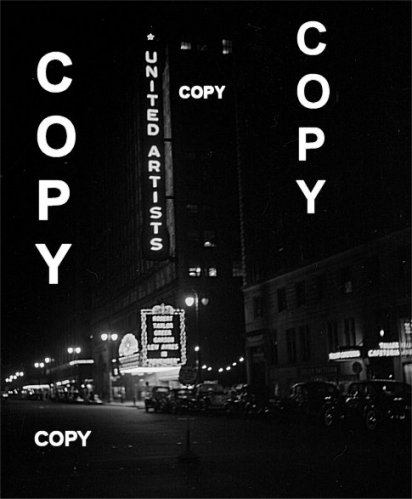 United Artists - Night Photo - 1939 The movie is Remember starring Robert Taylor, Greer Garson and Lew Ayres. Ookpik | ||
Kenp Member Username: Kenp Post Number: 961 Registered: 03-2006 |
I had never heard of the Riviera so I did some research and found this link with many great pics. It seems such a shame its gone. Thanks for the info Gistok, good info. http://www.waterwinterwonderland.com/location.asp?id=611&type=5 (Message edited by kenp on January 04, 2008) | ||
Jjaba Member Username: Jjaba Post Number: 5903 Registered: 11-2003 |
Kenp, jjaba and his girlfriend were ushers for the Broadway shows at The Riviera in the 1950s. Sited on the confluence of 7 streetcar lines at Joy Rd. and Grand River, it was a real draw and a beaudy. There have been other threads about it. You'll find some wonderful pictures there. Gistok tells it like it tis. He's The Source for movie houses in Detroit and all over the World. jjaba, Westsider. | ||
Kenp Member Username: Kenp Post Number: 963 Registered: 03-2006 |
Any stories of famous performers at the Riviera, jjaba. I wonder what jjaba did on those slow nights in the upper balcony with his girlfriend. Thanks for the tip on other threads, I will be searching. | ||
Jjaba Member Username: Jjaba Post Number: 5907 Registered: 11-2003 |
We had to stand tall all night. That's what we did. There was plenty of work, although we did see the shows. As for famous people, jjaba has long forgotten. jjaba is sure somebody has a playlist of the shows there. | ||
Rsa Member Username: Rsa Post Number: 1368 Registered: 10-2003 |
kenp, just don't ask jjaba about what he did with his girlfriend at tiger's games! ;) | ||
Kenp Member Username: Kenp Post Number: 967 Registered: 03-2006 |
Another interesting extinct theater. http://www.stevenball.com/Holl ywoodTheater.htm | ||
Gistok Member Username: Gistok Post Number: 6054 Registered: 08-2004 |
Thanks for the links Kenp... The Hollywood was Detroit's largest neighborhood theatre. When it opened in 1927, it was thought that downtown Detroit would expand westward and sooner or later the Hollywood would be part of a greater downtown. Well as we all know, the depression stopped the expansion of downtown. And the Hollywood was too far out of the way for most movie goers. The Hollywood was designed by Charles N. Agree (not mentioned in that link), the same architect of the Lee Plaza, the Whittier and the Keane Apts., as well as the Grande and Vanity Ballrooms. When he received the commission for the Hollywood Theatre in 1926, Charles N. Agree didn't have a lot of experience in theatre designs (most of his other local theatre commissions such as the Harper and Woods Theatres came in the 1930's), so he got the assistance of the Chicago architectural firm Graven & Mayger... the folks who were about to take on the designing of the Fisher Theatre. Charles N. Agree had his architectural offices in the Book Tower, but later moved to Bloomfield Hills, where he lived. He died in 1982. The Hollywood did not have 4,000 seats... but only 3,434 seats (50 more than the Capitol). As stated on another thread, theatre owners loved to inflate their seating counts. Unlike most of the larger downtown movie palaces, the Hollywood did not have a mezzanine level... only a main floor (orchestra seating) and a balcony. It was built in a sort of Spanish Renaissance/Classic style, and sadly was pounded to rubble in 1963, a great loss. Since the theatre was razed about 20 years before Mr. Agree died, one wonders how the architect felt about losing one of his best works? It must have been the same way for Walter W. Ahlschlager (designer of our Wonder Bread Factory)... who in 1961 (years before his death) saw his most famous commission, NYC 5,920 seat Roxy Theatre pounded to rubble. | ||
D2dyeah Member Username: D2dyeah Post Number: 88 Registered: 09-2005 |
The Hollywood theatre was near my grandparents house and to be taken there in the 50's was a real treat. They had that beautiful fountain by the concession stand. I remember my mom and her brothers and sisters being really disappointed when it closed. | ||
Gistok Member Username: Gistok Post Number: 6055 Registered: 08-2004 |
Exmotowner... don't know the status on the Detroit United Artists Building... The only thing is that the Ilitch folks repaired the roof on the theatre and office building. So although much damage has been done to the plaster shell, no further damage is anticipated. It all hinges now on where Quicken will pick as their HQ. I noticed one of the DetroitYES forumers mentioned a "Quicken Center for the Performing Arts" on the YAHOO Quicken thread. One other thing... the United Artists interior is no worse than the interior of the National Theatre. Both theatres have severe damage to their plaster shell. Here are some very interesting pictures of the United Artists Building. http://www.flickr.com/search/g roups/?q=United%20Artists&w=37 628493%40N00&m=pool Note much of the damage shown is PLASTERWORK. And plasterwork can be replaced/repaired. Remember... 90% of the plasterwork of the Detroit Opera House is replacement plasterwork. Also, the holes in the ceilings are now repaired. | ||
Exmotowner Member Username: Exmotowner Post Number: 446 Registered: 06-2005 |
well we can only hope then. I was in the Grand Circus Theater 2 weeks before it closed. It was in bad shape, but I didnt think this bad. Thanks Gistok, I know you'll keep us updated. | ||
Gistok Member Username: Gistok Post Number: 6057 Registered: 08-2004 |
Exmotowner... the Grand Circus Theater 2 weeks before it closed in 1985... and 4 years later when Michigan Opera Theatre purchased it... there was quite a difference. The previous owners abandoned the building, the pipes burst above the theatre, and havoc reigned throughout. There was even a piano floating in a pool of water in the orchestra pit back in 1989. When I visited it in 1991 (before any work was started)... you could not tell what colors the interior of the theatre had. | ||
56packman Member Username: 56packman Post Number: 1968 Registered: 12-2005 |
Here's a trip down memory lane--the auction where AAA stripped the UA of all its charms. Up until this point EVERYTHING was there, the only major alteration was the widening of the proscenium arch for wide screen movies and a white wash paint job. All the furniture, light fixtures, knick-knacks, the Wurlitzer organ--all there, all gone one month later. In February of 1975 AAA must have known they were building the tinker toy HQ building in Dearborn, which makes this money-grab all the more bitterseweet. I was in the UA before the auction, and again one week later. IT was truly all there. 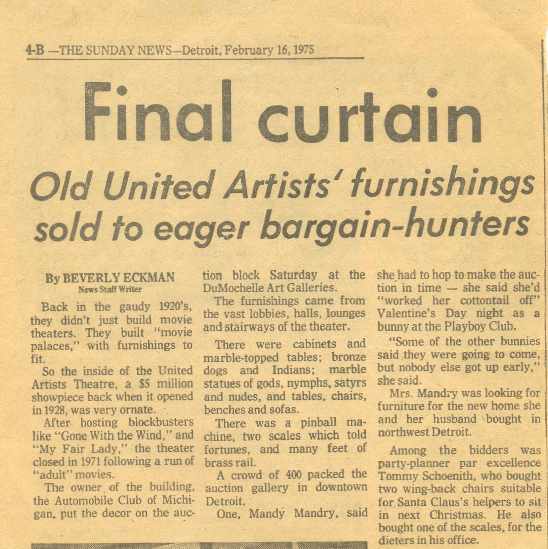 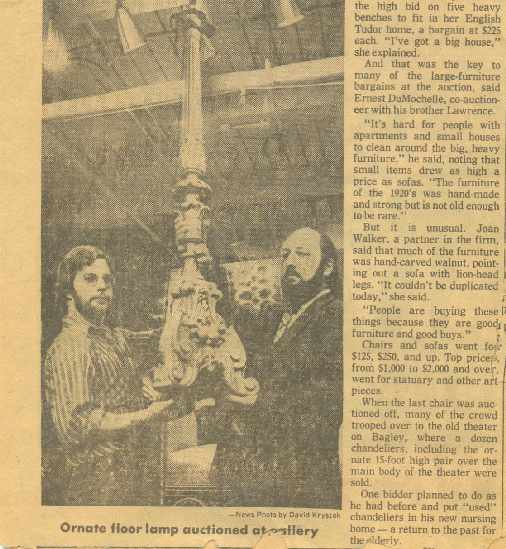 | ||
Whithorn11446 Member Username: Whithorn11446 Post Number: 173 Registered: 03-2007 |
"Charles N. Agree had his architectural offices in the Book Tower, but later moved to Bloomfield Hills, where he lived. He died in 1982." In the 1960's Charles Agree lived at 660 Whitmore just south of Palmer Park, which is one of the apartment buildings. | ||
Miketoronto Member Username: Miketoronto Post Number: 760 Registered: 07-2004 |
What amazing pictures. I went to the annual Theatre District tour in Aug, and I had this older gentleman who tagged along next to me(I was alone and so was he), and he would tell me what the theatre was like in its heyday as we toured them. It was really interesting. The interesting thing he said was that the Michigan Theatre was better then the fox. He said the Fox is great and the style is over the top and guady in a good way. But the Michigan according to him was the classy place. It was the theatre to go to to impress a date, etc. | ||
Exmotowner Member Username: Exmotowner Post Number: 447 Registered: 06-2005 |
WOW Gistok, You amaze me! I didnt realize there was so much damage done between when the Grand Circus closed and when restoration started. What a shame that sometimes things go the way they do. Thanks for the info. I always look forward to reading your posts. | ||
56packman Member Username: 56packman Post Number: 1969 Registered: 12-2005 |
The Grand Circus suffered from the double-whammy of having been operated by a rock concert only promoter (historically not a proven way to sustain a theater building, rather a one-way ticket to death by 0% maintenance leading to apathy, as in the case of the Michigan theater) and a subsequent owner from Baltimore who was only vaguely aware that he owned the building, and whose sole interest in the property was as a tax write-off. It is a miracle that the Capitol/Paramount/Grand Circus/Opera House survived and is now the cultural center is today. The 70s and 80s were a tough decade on these theaters in Detroit. They survived the demolition derby of the 50s and 60s; many fine palaces in other cities (where the price of real estate is much higher) were brought down in their prime. Detroit still had them all at the beginning of the 70s, and they were all in pretty good shape. The Grand Circus was in great shape in 1976 when I first visited it. It would have only required a seat restoration and an electrical upgrade to be a fully functional performing arts theater. The Michigan was all there, the furniture had been given to the DIA, who didn't quite know what to do with it, they were great reproductions of period French furniture, but had no museum-grade pedigree or provenance. The music library from the Michigan, thousands of full orchestrations were given to Wayne State University, who promptly threw most of it in the dumpster when one professor deemed it "that 19th century thematic junk". The UA was open until '72 or so when two notorious brothers in Detroit-area movie house history ran it, then it became AAA's temporary money farm. I'm thankful for the Fox (having had a small part in its preservation during a particularly bleak period in its history) and very happy about the Capitol/Opera House--for a while I thought that too far gone. | ||
Gistok Member Username: Gistok Post Number: 6060 Registered: 08-2004 |
Thanks for that 1939 black/white photo Ookpik!! Although it doesn't provide a lot of specific details, it does provide one important clue about the United Artists Building. The windows on the blank wall side of the building were in place by 1939! So sometime between opening in 1928 and that 1939 picture, that side of the building was remodeled with windows added. 56packman, I think a lot of people envy you being at all those theatres back then. Lucky bastard!  | ||
Gistok Member Username: Gistok Post Number: 6061 Registered: 08-2004 |
56packman, I do believe it likely that you and I were both at the Fox Theatre at the same time back circa 1985 (before restoration)... for the legendary theatre organist Gaylord Carter's concert. I had never been to a movie palace before that point, and was stunned at the faded opulence of the legendary Detroit Fox, and the majesty of its' mighty 4/36 Wurlitzer Organ. Mr. Carter, theatre organist to the stars during the silent film era, put on a wonderful show. It was awesome seeing the organ rising up into view onto the stage, while Mr. Carter was playing it. http://en.wikipedia.org/wiki/G aylord_Carter I've always wondered how the mighty Wurlitzer, one of 4 New York Paramount duplicates made for the Fox theatre chain in 1928-29... compared to Germany's Passau Cathedral organ, the worlds largest church organ. | ||
Lilpup Member Username: Lilpup Post Number: 3251 Registered: 06-2004 |
Don't know who all else was at the Riviera, but Judy Garland was one who played there, mid-1950s I believe. | ||
Gistok Member Username: Gistok Post Number: 6064 Registered: 08-2004 |
Interestingly enough, the Nederlander organization used the Riviera (known during its' life as either the Riviera or Grand Riviera) for their shows in the 1950's. Then in 1961 they moved their acts to the Fisher, which they remodeled for their use as a legitimate theatre. | ||
56packman Member Username: 56packman Post Number: 1971 Registered: 12-2005 |
Gistok--the Paramount/Fox organs (officially known as "4/36 specials" by Wurlitzer) are to any Cathedral organ (classical organ) as a sports car is to a stake truck. Some things are the same, but most are really, really different. I knew Gaylord Carter (aptly named) a great fellow who really enjoyed life. Growing up in little (then) Los Angles he knew most of the giants of the silent screen, most notably Harold Lloyd. He told some great stories of those days. | ||
Tponetom Member Username: Tponetom Post Number: 196 Registered: 06-2007 |
Talk about nostalgia. circa 1940-41. I am a little fuzzy on the date. My older sister took me downtown to the U. A. to see and hear Glenn Miller and his Orchestra. We got there at the right time to be seated for the next show. The ceiling of the theater was blue with'stars' sprinkled throughout. The lights dimmed to blackness for an eternity like, one minute or so. Then, the muted ceiling lights struggled for brightness and at the same time, the stage curtains flowed open to the strains of, "Moonlight Serenade." Bedlam followed. The audience got what they came for. Musical reverie that invaded their souls, forever. Viva la all the downtown theaters of that era. |